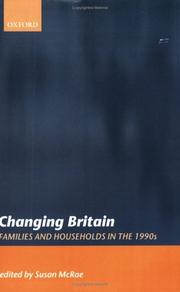| Listing 1 - 2 of 2 |
Sort by
|

ISBN: 0198296363 0198296371 Year: 1999 Publisher: Oxford Oxford University Press
Abstract | Keywords | Export | Availability | Bookmark
 Loading...
Loading...Choose an application
- Reference Manager
- EndNote
- RefWorks (Direct export to RefWorks)
Major changes have happened in households and people's lives in most countries in the developed world. Marriage rates have fallen, divorce has risen, women are having fewer children and later in life, and one in four families with children is headed by a lone parent. These changes have significance that goes beyond the individual families - with implications for housing demand, social security benefits, labour force participation, health and social services. This volume seeks to provide a comprehensive portrait of British families and households at the end of the 20th century. The book examines more generally the nature of economic and labour market change, Britain's place in Europe, and changing attitudes towards family life. Specifically, the book also deals with issues such as; older people's lives; non-heterosexual families; one-person households; young mothers and single parents; and divorce.
Sociology of the family. Sociology of sexuality --- anno 1990-1999 --- Great Britain --- Families --- Kinship --- Living alone --- Single-parent families --- Stepfamilies --- Unmarried couples --- Cohabitation --- Domestic partners --- Living together --- Couples --- Common law marriage --- Free love --- Blended families --- Combined families --- Remarried families --- Alone, Living --- Living by oneself --- One-person households --- Single living --- Households --- Lifestyles --- Ethnology --- Clans --- Consanguinity --- Kin recognition
Book
ISBN: 1009353586 1009353594 1316672751 1107160103 9781009353588 9781009353595 9781316672754 9781107160101 9781316612910 Year: 2023 Publisher: Cambridge, United Kingdom ;New York, NY Cambridge University Press
Abstract | Keywords | Export | Availability | Bookmark
 Loading...
Loading...Choose an application
- Reference Manager
- EndNote
- RefWorks (Direct export to RefWorks)
Drawing from stratification economics, intersectionality, and respectability politics, The Love Jones Cohort centers on the voices and lifestyles of members of the Black middle class who are single and living alone (SALA). While much has been written about both the Black middle class and the rise of singlehood, this book represents a first foray into bridging these two concepts. In studying these intersections, The Love Jones Cohort provides a more nuanced understanding of how race, gender, and class, coupled with social structures, shape five central lifestyle factors of Black middle-class adults who are SALA. The book explores how these Black adults define family and friends and decide on whether and how to pursue romantic relationships, articulate the ebbs and flows of being Black and middle class, select where to live and why, accumulate and disseminate wealth, and maintain overall health, well-being, and coping mechanisms.
Middle class African Americans --- African American women --- Middle class women --- Single women --- Living alone --- Lifestyles --- Social conditions --- Alone, Living --- Living by oneself --- One-person households --- Single living --- Households --- Spinsters --- Unmarried women --- Single people --- Women --- Afro-American women --- Women, African American --- Women, Negro --- African Americans --- Middle class --- Social conditions.
| Listing 1 - 2 of 2 |
Sort by
|

 Search
Search Feedback
Feedback About UniCat
About UniCat  Help
Help News
News